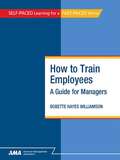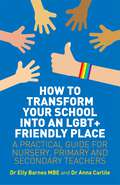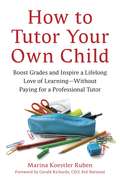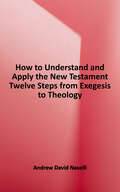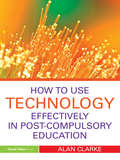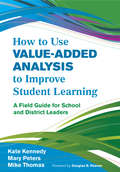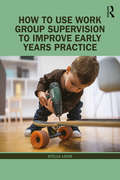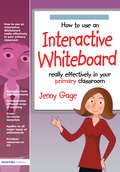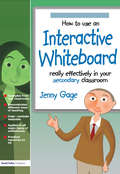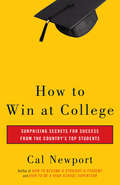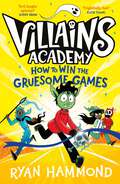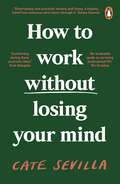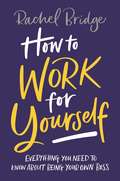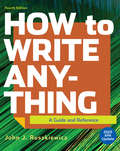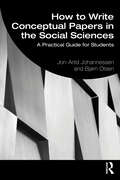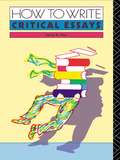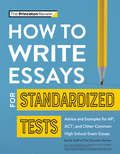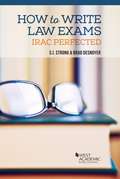- Table View
- List View
How to Thrive at Architecture School: A Student Guide
by Neil SpillerStudying architecture is hugely exciting and rewarding. It entails developing design skills, problem-solving abilities and tapping into creativity, as well as acquiring cultural, technical and professional knowledge. This book is the go-to guide for students throughout their architectural education. It introduces architecture students to all they need to know to get on an architecture course, thrive at school and be prepared for the realities of becoming a practising architect. Split into three main sections – Part I (BA or BSC in Architecture), Part II (Masters or Diploma) and Part III (Advanced Diploma in Professional Practice) – it offers direction on all aspects of an architectural education. These range from initial tutorials, the first crit and essay-writing through to the development of final project and thesis work. Covering all bases, it is a comprehensive guide for a student’s passage from university preparation through to undergraduate and graduate study and out into the profession. It features RIBA UK architecture schools and those validated overseas, as well as a short, final chapter on architectural education elsewhere in the world.
How to Train Employees: A Guide for Managers
by Bobette Hayes WilliamsonAssess, design, deliver, and evaluate training that is right for every employee. As the global marketplace expands, the need for a flexible, well-trained workforce grows with it. Training employees to master business-critical skills has become a baseline requirement for managerial success. This book provides the tools and techniques to assess, design, deliver and evaluate training that is right for every employee. Based on a four-part training process, this book provides cases, exercises, worksheets and planning forms that make the learning immediate and dynamic and allow you to assemble the elements of your own training programs as you progress through the course. You will learn how to: • Link training to short-term job requirements and the strategic needs of the business • Collaborate effectively with training professionals before, during, and after training • Determine the training needs of your employees • Describe training objectives and measures • Design a training program and create and use lesson plans for dynamic instruction • Apply proven principles of adult learning throughout the training process • Present both on-the-job and classroom training • Support the transfer of learning from the training session back to the job • Evaluate the effectiveness of training
How to Transform Your School into an LGBT+ Friendly Place: A Practical Guide for Nursery, Primary and Secondary Teachers
by Elly Barnes Anna CarlileCurrently teachers don't receive the training or induction they need to make their school an LGBT+ inclusive environment. This can be seen by the fact that half of schools do not teach anything regarding LGBT+, and only 3% include LGBT+ content in two or more subjects. This book will help transform your school into a safe and inclusive place for all students. Written with Educate & Celebrate!, an Ofsted and DFE recognised 'Best Practice Award Programme', this book gives teachers, governors and other staff the knowledge, strategies and confidence they need to implement a curriculum that is inclusive for all. Covering the changes to law, including the Equality Act 2010 which requires actively promoting acceptance, what language to use, case studies and much more, it is a must have guide for all schools.
How to Turn Learners On... Without Turning Them Off: Ways to Ignite Interest in Learning
by Robert Mager<p>How to Turn Learners On gives you the power to increase student motivation and develop positive attitudes in your learners. You'll learn to: <p> <li>Minimize actions that result in negative attitudes toward a subject <li>Maximize actions that make students enjoy learning <li>Model the performances you want to result from instruction so students can learn by example <li>Get learners excited about what you are teaching <li>Make them eager to learn more <li>Reduce frustration and prevent learners from giving up</li> </p>
How to Tutor Your Own Child: Boost Grades and Inspire a Lifelong Love of Learning--Without Paying for a Tutor
by Marina Koestler RubenTutoring today is a $4 billion industry (yes--billion) with companies like Sylvan Learning Center and Kaplan Tutoring cashing in. What are parents of today's overextended students to do? If only there were a resource closer to home that was easy, free, and able to provide the same quality of service. But there is: you. Top professional tutor Marina Koestler Ruben empowers you to take a do-it-yourself approach to your child's after-school enrichment. As a parent-tutor, you will learn how provide holistic academic support for your children and create an intellectual environment in the home--strengthening your relationship and improving parent-child communication in the process. Ruben's accessible guide shows you how to balance big-picture curiosity with the academic nitty-gritties of homework assignments, organization, and electronic resources. Building on her proven "Six-Step Session" format, Ruben shares the secrets to tutoring children in any subject from kindergarten through high school--all with a warm, entertaining tone that will inspire you to inspire them.From the Trade Paperback edition.
How to Understand and Apply the New Testament: Twelve Steps from Exegesis to Theology
by Andrew David NaselliIn his easy-to-understand guide to New Testament exegesis, Andrew Naselli explains and illustrates each step of a logical twelve-stage interpretive process that pastors, scholars, teachers, and laypeople can use with benefit. Move from genre to textual criticism, take Greek grammar and literary context into account, and journey through the passage all the way to practical application. Learn how to track an author's thought flow, grasp the text's message, and apply the ancient Word in this modern world, all in light of Christ's redeeming work. Then plunge into Naselli's recommended resources to go further in your studies every step of the way.
How to Use Technology Effectively in Post-Compulsory Education
by Alan ClarkeThe use of technology within the lifelong learning sector brings many benefits to learners, teachers and managers. Aimed at trainee and practising teachers, this book contains clear, practical guidance on how to use technology and e-learning effectively to enhance all aspects of teaching and learning in the post-compulsory sector. Alan Clarke explains the technologies that are available and how to use them from whiteboards and virtual learning environments to digital photographs, podcasts and e-portfolios. Each chapter is fully aligned with the new LLUK standards and includes teaching strategies, practical examples and case studies to show how these work in practice. Chapters include guidance on: using e-portfolios, blogs and wikis to present and share information with colleagues and encourage reflection motivating students and promoting collaboration using mobile devices, discussion groups and forums how to use ICT to develop literacy and numeracy skills ways to keep up to date with new and emerging technologies using technology safely and securely. Including a wide range of activities, questions for reflective practice and links to further sources of information, this essential textbook will help trainee and practising teachers in post-compulsory education to understand the major ILT tools and use them confidently and effectively in their teaching.
How to Use Value-Added Analysis to Improve Student Learning: A Field Guide for School and District Leaders
by James M. Thomas Kate Kennedy Mary PetersA step-by-step guide to transforming student learning with value-added analysis <p><p> Value-added analysis is the most robust, statistically significant method available for helping educators quantify student progress over time. This book provides a field-tested continuous improvement model for using value-added information to increase student learning in both the classroom and schoolwide. The five-step process shows how to: <p> Create the conditions for success <p> Examine district, school, and classroom reports to assess strengths and challenges <p> Use these reports to create an improvement plan <p> Implement instructional changes <p> Evaluate and adjust the changes as the new school year starts
How to Use Work Group Supervision to Improve Early Years Practice
by Stella LouisHow to Use Work Group Supervision to Improve Early Years Practice presents a new model for supervision as a collaborative process, and explores how this process can benefit practitioners at all stages in their career to reflect on and improve their own practice. Supported by detailed case studies which contextualise Work Group Supervision, Louis offers practical support which will help practitioners develop their knowledge and skills, and to work together to develop a shared understanding and more successful practice. Louis covers a range of insightful topics to help practitioners utilise the Work Group Supervision method to improve their practice, including: What Work Group Supervision is and how it can help practitioners How to develop self-understanding and professional practice Theories on child observation, and using observation to tune into children The importance of respectful interactions as a leader and among peers How to Use Work Group Supervision to Improve Early Years Practice is ideal for Early Years practitioners and teachers, managers of Early Years settings and students on courses for leadership in Early Childhood settings.
How to Use an Interactive Whiteboard Really Effectively in Your Primary Classroom
by Jenny GageThis book helps teachers get to grips with using software and offers advice on the different classroom management, differentiation and learning styles issues involved in using a whiteboard in a classroom context by:* Covering issues specific to Primary school teachers integrating whiteboard teaching into their classrooms* Providing cross-curricular strategies that help teachers incorporate the board in a range of subjects* Including screenshots and photos that show what can be created and how to do it* Offering innovative ways of presenting curriculum topics* Including downloadable resources packed full of resources that teachers can develop for their own use.
How to Use an Interactive Whiteboard Really Effectively in your Secondary Classroom
by Jenny GageThis book helps teachers get to grips with using software and offers advice on the different classroom management, differentiation and learning styles issues involved in using a whiteboard in a classroom context by: * Covering issues specific to Primary school teachers integrating whiteboard teaching into their classrooms * Providing cross-curricular strategies that help teachers incorporate the board in a range of subjects * Including screenshots and photos that show what can be created and how to do it * Offering innovative ways of presenting curriculum topics * Including a CD packed full of resources that teachers can develop for their own use.
How to Win at College: Surprising Secrets for Success from the Country's Top Students
by Cal NewportThe essential guide to getting ahead once you&’ve gotten in—proven strategies for making the most of your college years, based on winning secrets from the country's most successful students&“Highly recommended because it is full of practical tips that will help high school grads take the next step in life.&”—MoneyHow can you graduate with honors, choose exciting activities, build a head-turning resume, gain access to the best post-college opportunities, and still have a life? Based on interviews with star students at universities nationwide, from Harvard to the University of Arizona, How to Win at College presents seventy-five simple rules that will rocket you to the top of your class. These often surprising strategies include:• Don&’t do all your reading• Drop classes every term• Become a club president• Care about your grades, Ignore your GPA• Never pull an all-nighter• Take three days to write a paper• Always be working on a &“grand project&”• Do one thing better than anyone else you knowProving you can be successful and still have time for fun, How to Win at College is the must-have guide for making the most of these four important years—and getting and edge on life after graduation. &“This deliberately provocative book is a good way for a smart student to see how out-of-the-box thinking can lead to success in college.&”—Seattle Times
How to Win the Gruesome Games (Villains Academy #3)
by Ryan HammondBeing BAD has never felt so GOOD! The third book in the villainously funny, highly illustrated young middle-grade series from author-illustrator Ryan Hammond. For fans of Amelia Fang, Dog Man and Grimwood. Check out the complete series – Villains Academy and Villains Academy: How to Steal a Dragon. &‘Heart-warming and hilarious – Villains Academy is a spookalicious treat, set to terrify every other book on your shelf.&’ Jack Meggitt-Phillips, author of The Beast and the Bethany &‘An absolute HOOT! Evil laughs aplenty!&’ Sophy Henn, author and illustrator of the Pizazz series Once a year the five original founders of Villains Academy rise from their graves in honour of the Gruesome Games – a school sports day unlike any other, where the aim is to prank and cheat your way to the finish line. Werewolf Bram and his friends the Cereal Killers are determined to win so their names can be written in the Book of Bad, a record of the most wicked villains to grace the school. But as the games become harder and the pranks get out of hand, are Bram and his friends bad enough to go down as the most victorious villains in history? PRAISE FOR VILLAINS ACADEMY: &‘A charmingly villainous adventure about friendship, school and unspeakable evil.&’ Louie Stowell, author of Loki: A Bad God&’s Guide to Being Good &‘Criminally fun!&’ Danny Wallace, author of The Day the Screens Went Blank &‘Frightfully fun – Villains Academy had me cackling from the very first page!&’ Katie Tsang, co-author of the Dragon Realm series &‘I loved the spookily funny Villains Academy. It's a work of (evil) genius!&’ Jenny McLachlan, author of The Land of Roar &‘A joyful hug of a book with genuine warmth and heart.&’ Hannah Gold, author of The Last Bear &‘A delightfully fun adventure with real heart and humour.&’ Benjamin Dean, author of Me, My Dad and the End of the Rainbow &‘Immersive, funny, and with a cast of scarily loveable characters, Villains Academy made me feel like I was IN the book!&’ Mel Taylor-Bessent, author of The Christmas Carrolls &‘A fabulously funny adventure. I want to enrol in Villains Academy!&’ Nick Sheridan, author of The Case of the Runaway Brain &‘Wickedly funny and full of quirky yet loveable characters.&’ Iona Rangeley, author of Einstein the Penguin &‘This is a brilliant, bonkers work packed with top-notch illustration.&’ Jack Noel, author and illustrator of the Comic Classics series &‘Full of wonderful characters, Villains Academy is such a FUN read!&’ Rikin Parekh, illustrator of The Worst Class in the World series
How to Work Without Losing Your Mind
by Cate Sevilla'Genuinely empowering' Daisy Buchanan'An invaluable guide to surviving professional life' Viv Groskop'Comforting during these uncertain times' Yomi AdegokeAward-winning journalist and editor-in-chief Cate Sevilla has survived the messy, stressy and sometimes bizarre world of work - just.In How to Work Without Losing Your Mind, she gives an unflinchingly honest account of the bad bosses, the time spent crying in work loos, the hell and humiliation of her working life but, most importantly, she reveals the solid self-belief, the sage advice and the hard-won lessons that got her through.Filled with humour, wit and supportive words, this book is your essential guide to fixing your relationship with your work. Press it into the hands of every womxn who is sinking in a toxic work environment, battling burnout, recovering from redundancy or trying to find the right career fit. 'Entertaining and practical; moving and funny; a helping hand from someone who's been through it' Emma Gannon, Sunday Times bestselling author
How to Work for Yourself
by Rachel BridgeWorking for yourself can be an incredibly rewarding way of making a living, giving you more freedom, control, fun, satisfaction and even money, than you could have imagined. But if you have never done it before, it can be difficult to know where to start, how to get established and the pitfalls to look out for along the way. This book is a step-by-step guide, showing you how to do it in an effective, fulfilling and rewarding way. Drawing on Rachel Bridge's extensive experience and those of many others who already work for themselves, it contains practical advice and information, real-life examples and essential top tips to help you make a successful transition to working for yourself. You'll learn how to decide if this is the right path for you, how to get started, the key issues you need to think about and how to overcome obstacles and setbacks - not just from a practical point of view, but from a personal, financial and emotional perspective too.So whether you are currently in a salaried job and exploring the idea of going it alone, about to take your first step into the workplace after school or university, have just been made redundant or are already working for yourself, but need help and guidance on how to do it better, this is the book for you.
How to Work for Yourself
by Rachel BridgeWorking for yourself can be an incredibly rewarding way of making a living, giving you more freedom, control, fun, satisfaction and even money, than you could have imagined. But if you have never done it before, it can be difficult to know where to start, how to get established and the pitfalls to look out for along the way. This book is a step-by-step guide, showing you how to do it in an effective, fulfilling and rewarding way. Drawing on Rachel Bridge's extensive experience and those of many others who already work for themselves, it contains practical advice and information, real-life examples and essential top tips to help you make a successful transition to working for yourself. You'll learn how to decide if this is the right path for you, how to get started, the key issues you need to think about and how to overcome obstacles and setbacks - not just from a practical point of view, but from a personal, financial and emotional perspective too.So whether you are currently in a salaried job and exploring the idea of going it alone, about to take your first step into the workplace after school or university, have just been made redundant or are already working for yourself, but need help and guidance on how to do it better, this is the book for you.
How to Work for Yourself
by Rachel BridgeWorking for yourself can be an incredibly rewarding way of making a living, giving you more freedom, control, fun, satisfaction and even money, than you could have imagined. But if you have never done it before, it can be difficult to know where to start, how to get established and the pitfalls to look out for along the way. This book is a step-by-step guide, showing you how to do it in an effective, fulfilling and rewarding way. Drawing on Rachel Bridge's extensive experience and those of many others who already work for themselves, it contains practical advice and information, real-life examples and essential top tips to help you make a successful transition to working for yourself. You'll learn how to decide if this is the right path for you, how to get started, the key issues you need to think about and how to overcome obstacles and setbacks - not just from a practical point of view, but from a personal, financial and emotional perspective too.So whether you are currently in a salaried job and exploring the idea of going it alone, about to take your first step into the workplace after school or university, have just been made redundant or are already working for yourself, but need help and guidance on how to do it better, this is the book for you.
How to Write Anything: A Guide And Reference
by John RuszkiewiczInstructors at hundreds of colleges and universities have turned to How to Write Anything for clear, focused writing advice that gives students just what they need, when they need it. And students love it―because John Ruszkiewicz’s tone makes writing in any genre approachable, with a flexible, rhetorical framework for a range of common academic and real-world genres, and a reference with extra support for writing, research, design, style, and grammar.
How to Write Conceptual Papers in the Social Sciences: A Practical Guide for Students
by Jon-Arild Johannessen Bjørn OlsenThis book is a practical guide on how to write conceptual papers and use conceptual generalization as a research methodology. Divided into two parts, the book first focuses on the scientific foundation for conceptual generalization, to identify what is a conceptual model and how conceptual models can be developed. Part two focuses on how to write a winning conceptual thesis, covering conceptual generalisation and empirical generalisation, and discusses research problems and questions, and how to analyse them. The authors cover different conceptual and analytical models to offer students a multitude of tools to visualize, interpret and uncover relationships and patterns. For example, they explore the thought experiment, analytical models, empirical causal models, analytical forms and data mining models, and outline a strategy for developing conceptual models to assist with students who wish to design their own conceptual paper. Students gain a clear understanding of the driving forces in the research process, how to define a research problem, how to analysis the problem and develop research strategies. Moving from concepts to hypotheses, the book also covers the main types of errors that may be encountered as students learn about understanding the development of models and how to develop a theory. Also including a checklist for students, and a list of definitions and concepts, this is the ideal resource for advanced undergraduate and postgraduate students, and researchers, in the social sciences.
How to Write Critical Essays
by David B. PirieThis invaluable book offers the student of literature detailed advice on the entire process of critical essay writing, from first facing the question right through to producing a fair copy for final submission to the teacher.
How to Write Essays for Standardized Tests: Advice and Examples for AP, ACT, and Other Common High School Exam Essays (College Test Preparation)
by The Princeton ReviewMaster essays for standardized tests with The Princeton Review!No matter how much writing you've done in school, the timed essays you'll face on standardized tests present a whole new challenge. This essential guide expertly analyzes what graders are looking for across each of these standardized high school tests and then helps you swiftly and effectively meet their requirements. Steady your nerves and start preparing with: • Comprehensive coverages of AP, ACT, TOEFL, ISEE, and SSAT essay formats • Specific writing strategies to help ensure you're fulfilling the right criteria for each essay type • Annotated samples that show you how the grading rubrics are assessed • Tips on how to better support your answer for every kind of essay, including how to analyze textual, qualitative, and visual content and make calculations within an essay • Additional material on unique topics, such as foreign-language essay approaches and more!
How to Write Law Exams: IRAC Perfected (Career Guides)
by S. I. Strong Brad DesnoyerWritten for every law student who ever wondered how to get better grades in law school, How to Write Law Exams: IRAC Perfected provides students of all levels with a detailed, comprehensive, and practical guide to success on law school exams. What’s more, How to Write Law Exams applies equally to all subject matters, making this text an ideal supplement for every law school course. <P><P>Focuses on law school and bar exams rather than the kind of assignments seen in legal writing class. As such, the book helps students improve their grades in all of their substantive courses, not just in their first year legal writing class. <P><P>Provides readers with a proven and easy-to-implement means of maximizing points on a law school exam. Rather than repeating vague generalities about grammar and style or providing simple bullet-point lists as other writing guides do, this text breaks the well-known IRAC method of legal writing into comprehensible segments and gives students the tools needed to master their law exams. <P><P>Provides readers with detailed student-written examples of the IRAC method in action. Annotated with line-by-line critiques, these sample essays show readers exactly what can go wrong in a law school exam and how to fix those problems before they appear on a graded paper. <P><P>Combining in-depth analysis, easy-to-understand writing, and innovative design features, How to Write Law Exams: IRAC Perfected is the answer to every law student’s exam questions.
How to Write Like a Bestselling Author: Secrets of Success from 50 of the World's Greatest Writers
by Tony RossiterIlluminating the best-known works of 50 celebrated authors, writing coach Tony Rossiter shows you how they achieved their phenomenal success. He explains how each author began writing, and examines their style, techniques and routine for creative insights. If you want to write a bestseller, this guide will set you on the path to success.

